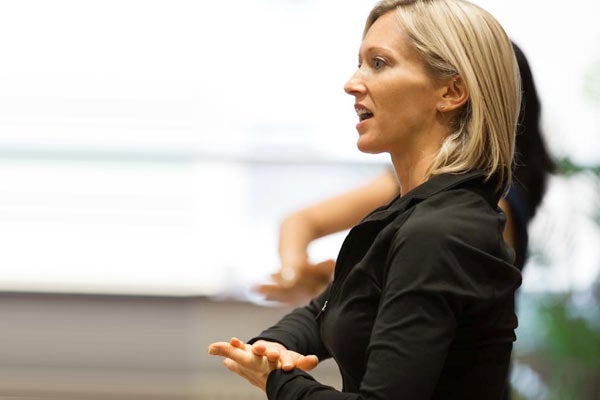
Movement breaks help learning, well-being
Published: October 3, 2012
Jill Cressy was three hours into a six-hour class when she realized that her shoulders were tense, her back was aching and she was beginning to lose her focus. The issue wasn’t the subject – Educational Finance and Economics. It was the sitting.
“I approached the professor, Dan Lang, and asked if I could lead a movement break,” she says. “Something to get our muscles moving and our circulation flowing.”
After a quick five minutes of shoulder rolls, balancing exercises, simple stretches and arm circles, Cressy and her fellow students in the Masters of Education, Higher Education program at OISE returned to work, re-energized and ready to concentrate.
“Movement breaks are a superb way to integrate physical activity and mental well-being into the classroom experience,” says Janine Robb, Executive Director of Health and Wellness. “It’s quick, simple and can be done by anyone.”
Dan Lang, a professor in the OISE Leadership, Higher & Adult Education program and former head coach for the Varsity Blues baseball team, can attest to the change the movement breaks have on his class. Lang says that although students were encouraged to take conventional breaks to eat or drink, it didn’t seem to make a difference.
“Movement breaks are a useful alternative to keeping attention focused, especially during the longer classes that are part of a compressed curriculum,” he says. “The breaks are fun. After, students seem to be more alert and concentration improves. Since we all do them, including me, the class has more cohesion and the gap between teacher and student narrows.”
The breaks are part of a larger movement on campus to ensure that the academic experience incorporates health and wellness. For instance, through MoveU, a partnership between U of T and ParticipACTION, student leaders are inspiring fellow students to keep active, and providing tips and news via their twitter feed and Facebook page.
Cressy points out that students, with their busy schedules, can often feel overwhelmed by competing pressures. The movement breaks provide easy, calming techniques that can be applied anywhere.
"One exercise is to press the palm of one hand into the other while paying attention to the breath. This simple activity can help to manage stress and can be done in a variety of settings from the library to the TTC."
So far, Cressy, who is also a Community Health Coordinator in Student Life, has led movement breaks in U of T’s Summer Leadership Institute (sponsored by the Institute for Leadership Education in Engineering and the Centre for Teaching Support and Innovation) and the Exploring Leadership Workshop (Office of Student Life, Leadership Programs). However, she says the breaks can be adapted for any classroom experience and are beneficial to both instructors and students.
U of T will be promoting other mental health and wellbeing strategies during Mental Health Awareness Month in October. One of the events will be an Oct. 22 screening at Victoria College of the movie Happy, which combines research on happiness with real-life stories to explore what happiness is.
“What’s so attractive about movement breaks is that they reinforce healthy habits that are useful now and in the future when students begin their careers,” says Robb. “A short break to stand and move around doesn’t take a huge time commitment, but the benefits to student success and mental well-being can be significant.”
Interested in having a movement break in class? Contact Jill Cressy for tips and resources. For more info on events taking place during Mental Health Month this October, visit Health and Wellness.



